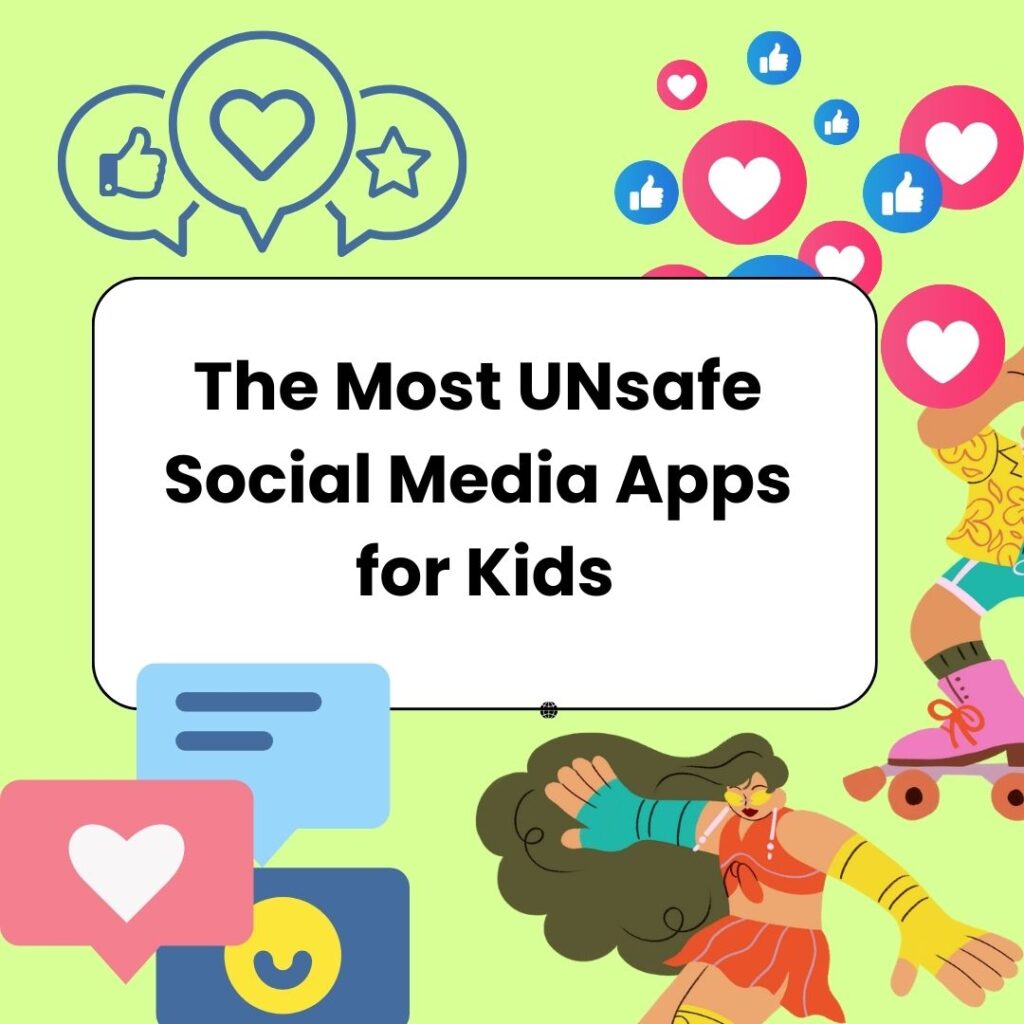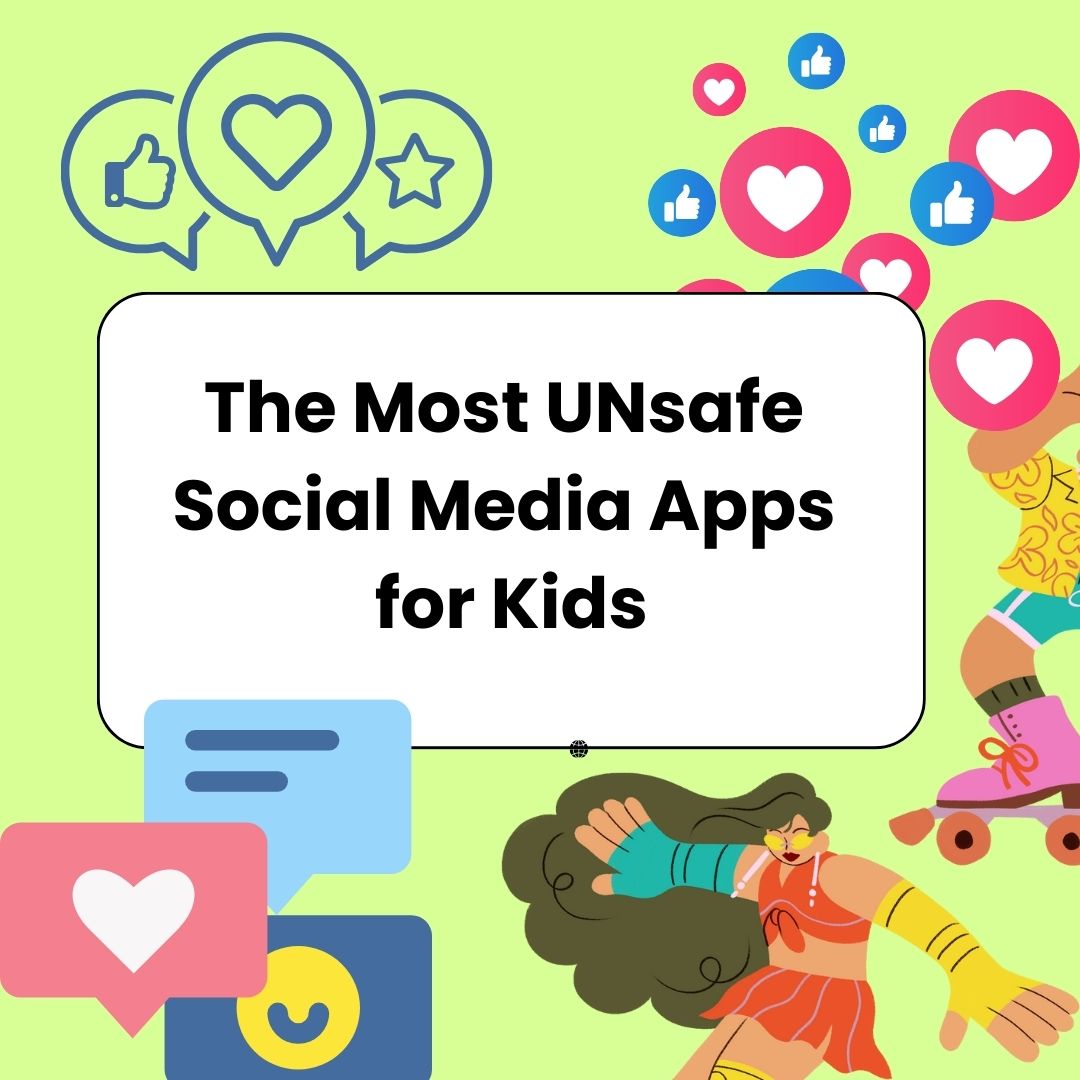
In this rapidly advancing digital age, a new app pops up daily. As teenage and kid culture has always operated at warp speed, our children are often the first to try out these new apps. The new and cool apps are constantly changing and getting more adventurous to lure in kids with the excitement of social interactions. We are going to highlight the most unsafe social media apps for kids to help parents navigate these troubling online environments.
Parenting today requires monitoring your child’s use of electronic devices regularly. Staying current on the apps your child may be downloading and using can be time-consuming. In this article, we will describe and inform you of the most unsafe social media apps for kids and give you some general guidelines you can enforce within your home. We will show you what to watch out for and how to catch problematic apps before they start.
General Guidelines:
Use helpful tools for parents.
There are tools, parental controls, and even apps that will help you monitor your child’s use of technology more efficiently. One easy and helpful tool on the iPhone is called Family Sharing. As a designated parent in your family account, you can use parental controls to require your child to get approval before downloading any app. I have used this feature with my children, and it continues to be life-saving and very enlightening, too. If navigating all of the parental controls of several apps sounds overwhelming to you, you can also use the parental control app Bark. I recommend these for any parent who wants help, like alerts and notifications, to monitor their child’s online life.
Teach your child about app age limits and ratings.
The Apple App Store and Google Play Store give ratings to apps and suggest a minimum age for the user. Please pay attention to these ratings and teach your children about them. Use this information to facilitate the conversation about how apps can be full of adult content and are inappropriate for younger users. If an app rating says 17+ and my 11-year-old is asking to download it, I can quickly point out that it is inappropriate for them. Now that he has learned about app ratings, he doesn’t even ask me to download the 17+ apps anymore.
In the Bark parental control app, you can set limits for the types of apps that your children can download. With Bark’s help, you never have to worry that your child is downloading an app with a mature rating.
Remind them of the rules for chatting and what you want them to do when they face uncomfortable messages.
Again, education is critical. Teach your children that not everyone online is who they say they are. Tell them, in age-appropriate language, that adults sometimes pose as children on apps to get them to trust them and use their information to gain money or access their identity.
Be sure to discuss with your children what to do if they receive a message or picture that makes them uncomfortable. Remind them that they will not be in trouble with you. Your goal should be to make them feel safe from punishment and judgment from you. They will likely come to you at the first sign of trouble if they feel safe reporting this.
And if you’re concerned that your child might not tell you when they rececive inappropriate messages, Bark can help you with that as well. Bark will monitor your child’s messages and alert you of any reference to violence, pornography or inappropriate content.
General rules for children when using chat features:
- Never chat with someone you don’t know in real life.
- Do not give any of your personal information to an unknown account.
- Tell a parent immediately of inappropriate or uncomfortable conversations, messages, or content.
These rules can be practical guidelines to protect your children in various apps. Now, let’s discuss apps that you, as a parent, should be even more wary of.
Top Most Unsafe Apps for Kids: in no particular order
- Discord
- Twitch
- Kik
- Snapchat
- Hoop
Discord
Online gamers use this app and site to connect via text, voice, and video. The problems with Discord include accessible adult content and the ability to chat privately with strangers. Kids who are under 18 can easily click through to view mature content. Unfortunately, the communication app is also a platform for pedophiles, sex traffickers, and hackers.
Twitch
Twitch is a live-streaming app used by gamers to grow their audience. Users can follow their favorite gaming influencers and watch and comment on their latest posts. Twitch uses chat rooms and requires no age verification. The app is recommended for children ages 12 and over.
Kik
Kik is a messaging app that allows teens to connect using only a username. Scammers and pedophiles can easily hide behind an anonymous account and have been known to use school names in their usernames to make it appear that they are students. Users text photos, drawings, or pre-designed greeting cards to individuals or groups. Because there is no age verification, experts report that Kik is popular with sexual predators. Moreover, Kik has also been used for cyberbullying.
Snapchat
Snapchat is the most popular of the apps on this list, with over 293 million users worldwide. This messaging app is known most notoriously for messages disappearing after they have been seen (or read) by the recipient. This disappearing act makes cyberbullying far too easy. Imagine the things teens and kids would say to each other from behind a screen when the message is instantly erased. As a school counselor, I regularly deal with the aftermath of a Snapchat incident between students. When you have no proof, stopping the behavior is very challenging.
Hoop
Remember how your parents told you never to talk to strangers? Hoop breaks this rule as it is designed to facilitate online conversations with random strangers. It has been described as a combination of Tinder and SnapChat. Hoop allows kids as young as 12 to make accounts. Users can text or video chat with people from more than 190 countries. Conversations on Hoop can easily result in sexually explicit content, lewd language, and references to drugs, alcohol, and violence.
Bark can help you protect your kids from the dangers these apps pose.
Your child wants to connect with friends on their phone or tablet, and thankfully, these dangerous apps are not the only options. There are better apps that have protective measures in place.
Two of my favorite safe social media apps for kids are:
Messenger for Kids
Messenger Kids is connected to a parent’s Facebook and Messenger accounts. It enables parental controls so you can see and approve all of your child’s contacts. It even creates reports to show you who your child is chatting with. Kids like it because it has fun filters and allows them to video chat safely and flexibly.
Youtube Kids
The parental controls in YouTube Kids allow your child to watch fun videos of age-appropriate material. They can also watch their favorite gaming influencer on YouTube Kids. However, YouTube Kids does not allow your child access to YouTube Shorts, which are similar to social media videos on TikTok or Instagram Reels. It is solely for watching longer videos of appropriate content.
Our children are at risk from apps with limited accountability and zero parental controls in the ever-changing digital world. Teach your children about the dangers of online interactions while safeguarding their identity and innocence. Keep them away from these unsafe apps and let them enjoy online gaming, videos, and chatting in a safer online environment.

